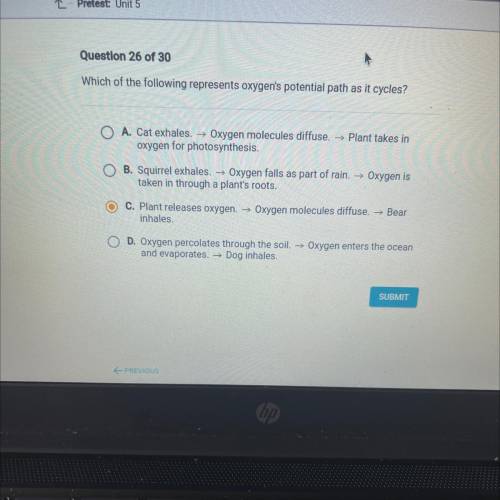Question 26 of 30
Which of the following represents oxygen's potential path as it cycles?
A....

Question 26 of 30
Which of the following represents oxygen's potential path as it cycles?
A. Cat exhales. → Oxygen molecules diffuse. → Plant takes in
oxygen for photosynthesis.
B. Squirrel exhales. Oxygen falls as part of rain. → Oxygen is
taken in through a plant's roots.
C. Plant releases oxygen. → Oxygen molecules diffuse. → Bear
inhales.
-
Oxygen enters the ocean
D. Oxygen percolates through the soil.
and evaporates. → Dog inhales.
SURMIT


Answers: 3


Another question on Biology

Biology, 21.06.2019 22:00
(drag each tile to the correct identify which questions can be answered by what can be answered by science or which cannot. -is it right or wrong to use genetic engineering to produce new food products? -what are the most common social settings that tend to produce accomplished artists? -if a new gene is added to the genome of a tomato species, will that species be more resistant to insects? -should humans use biotechnology to bring extinct organisms from the fossil record back to life? -do the types of organisms found in the fossil record appear in consistent sequences in different parts of the world? -are michelangelo's paintings more impressive than rembrandt's?
Answers: 3

Biology, 21.06.2019 22:00
Which statement best describes the relationship between an allele and a gene? question 1 options: an allele is a variation of a gene that can be expressed as a phenotype. an allele is the part of a gene that attaches to messenger rna molecules. an allele is a segment of a dna molecule that controls replication of a gene.
Answers: 3

Biology, 22.06.2019 02:00
The accompanying figure shows the percent of selected dna sequences that match between a chimpanzee and other primates. these data support the hypothesis that the figure shows the percentage of selected d n a sequences that match between the chimpanzee and other primates. the human has an almost 98 percent match, the gorilla has an almost 97 percent match, the orangutan has a 96 percent match, the gibbon has an almost 95 percent match, and the old world monkey has an almost 92 percent match. the accompanying figure shows the percent of selected dna sequences that match between a chimpanzee and other primates. these data support the hypothesis that the figure shows the percentage of selected d n a sequences that match between the chimpanzee and other primates. the human has an almost 98 percent match, the gorilla has an almost 97 percent match, the orangutan has a 96 percent match, the gibbon has an almost 95 percent match, and the old world monkey has an almost 92 percent match. chimpanzees and gibbons are the most closely related the chimpanzee's closest surviving relative is humans orangutans are the primates least closely related to chimpanzees old world monkeys and gibbons are the most closely related
Answers: 1

Biology, 22.06.2019 06:00
What element is able to combine with itself and hydrogen to form large molecules ?
Answers: 1
You know the right answer?
Questions

Biology, 22.12.2019 06:31


English, 22.12.2019 06:31






Computers and Technology, 22.12.2019 06:31

Biology, 22.12.2019 06:31







Biology, 22.12.2019 06:31






